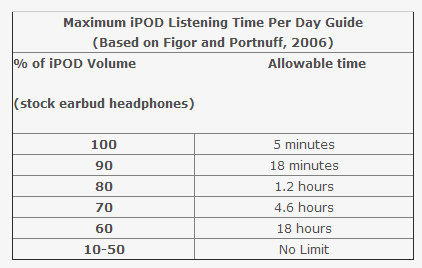Almost 12 percent of children between ages 6-19 have noise-induced hearing loss

(Medical Xpress)—Does your child or teen spend hours "plugged in" to an iPod? Tuning out may be doing more than irritating parents. It is estimated that almost 12 percent of all children between the ages of 6-19 have noise induced hearing loss (NIHL), according to the American Speech, Language and Hearing Association. NIHL has become a widespread and serious public health issue, which can occur at any age.
Although construction workers and military personnel are routinely exposed to excessive noise levels that cause hearing loss, recent research suggests that listening to music through an iPod or other device at certain sound levels may also be hazardous to hearing. Given that many children and adolescents spend many hours "plugged in" to their devices, some precaution should be used to prevent hearing loss.
The outer ear receives sound waves and funnels them down the ear canal to the eardrum and then to the inner ear. The inner ear is a snail-shell-like organ, called the cochlea. Inside the cochlea, there are thousands of hair cells which are actually responsible for our hearing because they transmit sounds up to the brain. Scientists believe that NIHL damages hair cells in the inner ear, causing loss of the ability to transmit sound. NIHL is gradual and painless, but eventually it is permanent. Once damaged, the tiny hair cells in the inner ear cannot grow back.
Sound is measured in decibels. For example, normal conversational speech is typically measured at 60 decibels; hair dryers and lawnmowers are 90 decibels; rock concerts and car races can reach 110 decibels; and firearms and firecrackers often exceed 140 decibels. Any sound over 85 decibels is loud enough to damage your hearing. However, much like sun damage, the more intense the sound is, the shorter the amount of time you can be exposed to it before damage occurs.
What can you do to prevent hearing loss?
- Wear hearing protection: To eliminate unwanted noise, several options are available, such as ear muffs and ear plugs. Hearing protectors can be custom-made or individually molded and are available through local audiologists. Putting cotton in your ears does not work.
- Limit listening time: Take listening breaks from your iPod or other device to give your ears some recovery time.
- Walk away: The further you are from the noise, the less damage it will cause.
- Turn down the volume: Use the chart below to determine the maximum amount of time you can listen at different levels without risking hearing loss. How loud your iPod can be actually depends on the type of headphones you use.
In general, the standard ear-bud-style headphones that came with your iPod are slightly louder than over-the-ear-style headphones. For additional information about the preventing hearing loss, please visit www.turnittotheleft.com or www.dangerousdecibels.org.
















